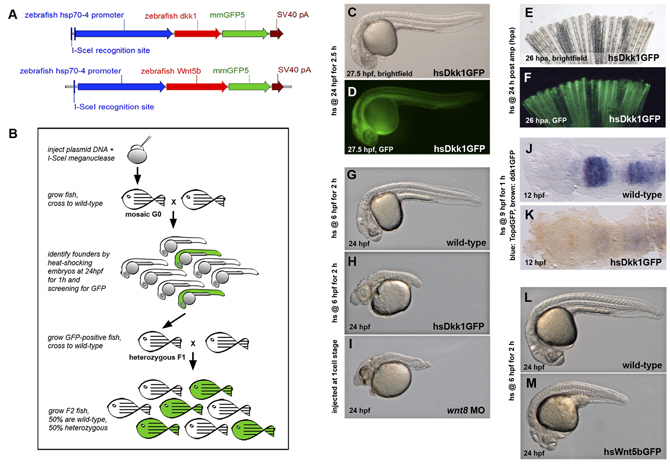Fig. S3 Establishment of heat-shock inducible Dickkopf1GFP and heat-shock inducible Wnt5bGFP transgenic zebrafish lines. (A) Maps of the transgenes used. (B) Strategy used to establish and characterize transgenic fish (see Materials and methods). (C,D) Heat-shock of heterozygous hsDkk1GFP transgenic embryos at 24 hpf for 2.5 hours results in ubiquitous expression of the Dkk1GFP fusion protein. (E,F) Heat-shock of heterozygous hsDKK1GFP transgenic adult fish for 1 hour causes expression of the fusion protein in amputated tail fins. (G-I) Heat-shock of heterozygous hsDkk1GFP transgenic embryos for 2 hours during gastrulation (starting at shield stage, 6 hpf) causes severe defects in anteroposterior patterning that closely resemble those caused by knockdown of both ORFs of wnt8 using translation-blocking morpholinos. Heterozygous carriers of the transgene were crossed to wild-type fish, and the resulting clutch of embryos heat shocked at 6 hpf for 2 hours. Wild-type and transgenic embryos were identified by GFP fluorescence, sorted and photographed at 24 hpf. (J,K) Overexpression of Dkk1GFP in embryos doubly transgenic for hsDKK1GFP and the reporter TOPdGFP is sufficient to suppress β-catenin-dependent expression of the TOPdGFP transgene. Heterozygous carriers of the hsDkk1GFP transgene were crossed to homozygous carriers of the TOPdGFP transgene. The resulting clutch of embryos was heat-shocked at 9 hpf for 1 hour, embryos fixed at 12 hpf and processed for two-color in situ hybridization with an EGFP probe detecting the TOPdGFP transgene in blue and a mmGFP probe detecting the dkk1GFP transgene in brown. The pictures show the head region of flat-mounted embryos, anterior left. Expression of TOPdGFP at this stage is primarily in the tectum and hindbrain. (L,M) Overexpression of Wnt5bGFP in embryos heterozygous for the hsWnt5bGFP transgene during gastrulation causes phenotypes typical for activation of β-catenin-independent Wnt signaling pathways, namely convergent-extension defects, resulting in short embryos with compressed somites and wavy notochord. Heterozygous carriers for the hsWnt5GFP transgene were crossed to wild-type fish, the resulting embryos heat shocked at 6 hpf for 2 hours, sorted into wild-type and transgenic carriers by GFP fluorescence and photographed at 24 hpf.
Image
Figure Caption
Figure Data
Acknowledgments
This image is the copyrighted work of the attributed author or publisher, and
ZFIN has permission only to display this image to its users.
Additional permissions should be obtained from the applicable author or publisher of the image.
Full text @ Development

